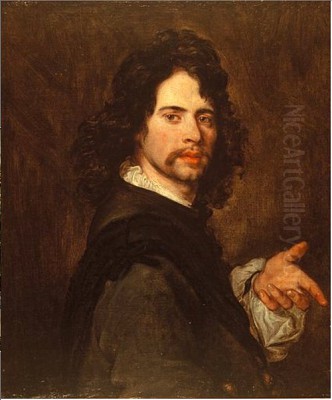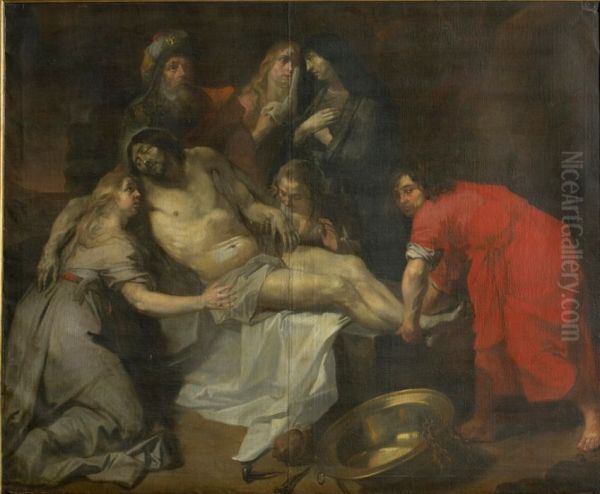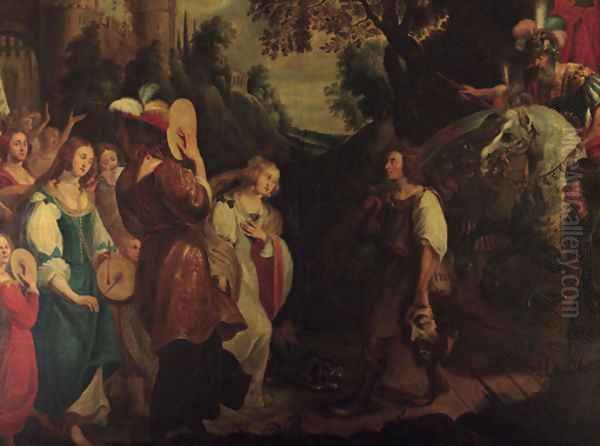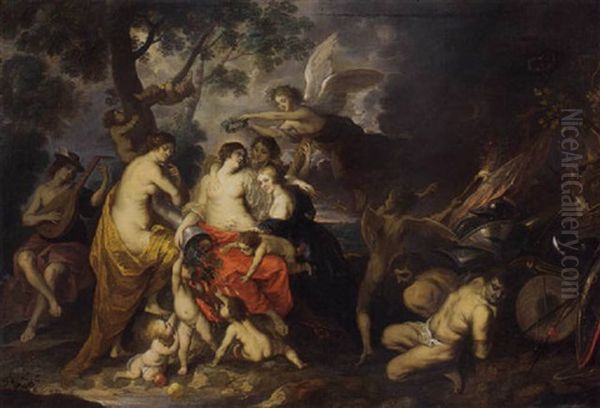
Jan van den Hoecke (1611–1651) stands as a significant, if sometimes overlooked, figure in the vibrant artistic landscape of 17th-century Flanders. A painter, draughtsman, and tapestry designer, he navigated the rich currents of the Baroque era, absorbing influences from his illustrious contemporaries while forging a distinct artistic identity. Born and deceased in the bustling art metropolis of Antwerp, Van den Hoecke's career saw him traverse geographical and artistic boundaries, from the hallowed workshops of Antwerp to the imperial courts of Central Europe, leaving behind a legacy of refined and expressive works.
Early Life and Artistic Formation in Antwerp
Jan van den Hoecke was born into an artistic family in Antwerp in August 1611. His initial artistic training came from his father, Gaspar van den Hoecke the Elder (c. 1585–1648), a painter of modest renown who specialized in historical and religious subjects. This familial introduction to the painter's craft provided a foundational understanding of technique and composition. However, the most formative period of his early development was undoubtedly his apprenticeship in the workshop of Peter Paul Rubens (1577–1640), the towering figure of Flemish Baroque art.
Entering Rubens's studio, likely in the late 1620s or early 1630s, placed Van den Hoecke at the epicenter of artistic innovation and production in Northern Europe. Rubens's workshop was a highly organized and prolific enterprise, attracting talented pupils and collaborators who assisted the master in executing his numerous commissions. Here, Van den Hoecke would have been immersed in Rubens's dynamic style, characterized by vigorous movement, rich color, dramatic lighting, and a profound understanding of classical and Renaissance art. He would have learned to work on large-scale canvases, contribute to collaborative projects, and master the diverse genres in which Rubens excelled, from monumental altarpieces to mythological narratives and state portraits.

The influence of Rubens is palpable in Van den Hoecke's early works, evident in the robust figural types, the energetic compositions, and the warm, luminous palette. He participated in significant projects emanating from Rubens's studio, most notably the decorations for the 1635 Joyous Entry (Pompa Introitus Ferdinandi) of the Cardinal-Infante Ferdinand of Austria into Antwerp. For this grand civic celebration, Rubens designed a series of triumphal arches and stages adorned with large allegorical and historical paintings. Van den Hoecke, alongside other prominent Rubens pupils and collaborators like Jacob Jordaens (1593–1678) and Theodoor van Thulden (1606–1669), was entrusted with executing some of these monumental canvases based on Rubens's oil sketches (modelli). This experience provided invaluable training in large-scale decorative painting and public art.
The Italian Sojourn and Its Impact
Like many ambitious Northern European artists of his generation, Jan van den Hoecke undertook a journey to Italy to study firsthand the masterpieces of classical antiquity and the Italian Renaissance and Baroque. While the exact dates of his Italian sojourn are not definitively documented, it is generally believed to have occurred between approximately 1635/37 and 1644, possibly with intermittent returns or stays elsewhere. This period was crucial for broadening his artistic horizons and refining his style.
In Italy, Van den Hoecke would have encountered the works of Renaissance giants such as Raphael (1483–1520), Michelangelo (1475–1564), and Titian (c. 1488/1490–1576), whose mastery of form, color, and composition had long been a touchstone for European artists. He would also have been exposed to the more contemporary currents of Italian Baroque art. The dramatic chiaroscuro and intense naturalism of Caravaggio (1571–1610) and his followers, the Carracci reform spearheaded by Annibale Carracci (1560–1609) and Agostino Carracci (1557–1602) which sought a synthesis of High Renaissance classicism and Venetian colorism, and the elegant classicism of artists like Guido Reni (1575–1642) and Domenichino (1581–1641) would all have offered diverse stylistic avenues.
The impact of this Italian experience is discernible in Van den Hoecke's work. While retaining the Flemish robustness inherited from Rubens, his style began to incorporate a greater sense of classical balance, a more refined linearity, and a cooler, more silvery palette in certain works. His figures sometimes acquired a more idealized and statuesque quality, reflecting an engagement with classical sculpture and High Renaissance principles. This classicizing tendency, tempered by his Flemish training, became a hallmark of his mature style, distinguishing him from some of his more exuberantly Baroque contemporaries in Antwerp. His time in Italy also likely involved direct commissions and interactions with Italian patrons and artists, further enriching his professional experience.
Service in Vienna: A Court Painter's Ascent

Around 1637, or perhaps slightly later after an initial period in Italy, Jan van den Hoecke traveled to Austria, where he entered the service of Emperor Ferdinand III (1608–1657) in Vienna. This appointment marked a significant step in his career, elevating him to the prestigious position of a court painter. The Habsburg imperial court was a major center of artistic patronage, and Vienna was a cosmopolitan city attracting artists from across Europe.
During his tenure in Vienna, which lasted for several years, Van den Hoecke was engaged in producing a variety of works for the Emperor and his court. These included religious paintings for chapels and private devotion, allegorical compositions celebrating the virtues and power of the Emperor, and portraits of the imperial family and prominent courtiers. His works from this period often exhibit a refined elegance and a sophisticated blend of Flemish and Italianate elements, tailored to the tastes of his imperial patrons.
One notable commission from this time was a series of paintings depicting the months, or allegories of the seasons, which often combined mythological figures with landscape and still life elements, showcasing his versatility. His religious paintings continued to be a significant part of his output, often characterized by a tender piety and a clear, legible narrative style. The experience of working within a courtly environment, with its specific demands for decorum, representation, and intellectual content, further honed Van den Hoecke's skills and adaptability as an artist. He was not the only Netherlandish artist at the Habsburg court; the tradition of employing Flemish and Dutch painters was well-established.
Return to Flanders and Service to Archduke Leopold Wilhelm
By 1644, Jan van den Hoecke had returned to his native Flanders. He initially settled in Antwerp, where he was admitted as a master in the Guild of Saint Luke in 1644-45. However, his connections with the Habsburgs remained strong. In 1647, he was appointed court painter to Archduke Leopold Wilhelm of Austria (1614–1662), who had become the Governor of the Spanish Netherlands and resided in Brussels. This was another highly prestigious appointment, as Archduke Leopold Wilhelm was one of the most important art collectors and patrons of his time.

As court painter to the Archduke, Van den Hoecke was responsible for a range of artistic duties. He painted portraits of the Archduke and his circle, created religious and mythological works for the Archduke's extensive collection, and, significantly, became heavily involved in tapestry design. The Archduke's collection, famously documented in a series of "gallery paintings" by David Teniers the Younger (1610–1690), who also served as the Archduke's court painter and keeper of his collection, was legendary for its Italian masterpieces. Van den Hoecke's presence at this court placed him in daily contact with an extraordinary array of artworks, which undoubtedly continued to inform his own artistic practice.
His association with Archduke Leopold Wilhelm lasted until Van den Hoecke's premature death in Antwerp in 1651. Despite his relatively short career, spanning roughly two decades, he produced a considerable body of work and achieved significant recognition in the highest circles of European society.
Artistic Style and Influences
Jan van den Hoecke's artistic style is a complex synthesis of various influences, primarily rooted in the Flemish Baroque tradition of Rubens, significantly modified by his Italian studies, and adapted to the tastes of his courtly patrons.
The foundational influence of Peter Paul Rubens is undeniable. From Rubens, Van den Hoecke inherited a dynamic sense of composition, a love for rich textures and vibrant (though often later tempered) colors, and a facility in depicting the human form with anatomical accuracy and expressive power. The grand scale and narrative ambition of many of Rubens's works also left their mark on Van den Hoecke's approach to historical and mythological subjects.
His time in Italy introduced a classicizing element. The influence of High Renaissance masters like Raphael and later classicists like Guido Reni and Domenichino can be seen in the more ordered compositions, the idealized figural types, and the smoother, more polished finish that characterize some of his works. This classicism provided a counterpoint to the more exuberant dynamism of the high Baroque, resulting in a style that was often more restrained and elegant. Some scholars have noted a particular affinity with the cooler palette and graceful figures of artists like Anthony van Dyck (1599–1641), Rubens's most famous pupil, who also successfully blended Flemish and Italian influences.
Van den Hoecke developed certain stylistic idiosyncrasies. His figures often have distinctive facial features, sometimes described as having large, slightly slanting eyes and somewhat exaggerated head shapes. His draperies can be rendered with sharp, angular folds, creating a sense of crispness and texture. His color palette, while capable of richness, often leaned towards cooler tones, with an appreciation for silvery grays, blues, and subtle harmonies, particularly in his later works. He demonstrated a keen ability to convey emotion, though often with a degree of subtlety and introspection rather than overt theatricality.
Major Works and Thematic Concerns
Jan van den Hoecke's oeuvre encompasses a range of subjects, including religious scenes, mythological and allegorical narratives, portraits, and designs for tapestries.
Religious Paintings:
Religious subjects formed a substantial part of Van den Hoecke's output, reflecting the devout Catholic atmosphere of Counter-Reformation Flanders and the piety of his patrons. Among his notable religious works is "The Entombment of Christ," a theme he treated with solemnity and pathos, often employing dramatic lighting to heighten the emotional impact. Works such as "Saint Francis Embraced by the Virgin" or "The Last Communion of St. Francis" (titles and specific scenes can vary in attribution and records) highlight his ability to depict moments of intense spiritual devotion. These paintings often feature carefully rendered figures, expressive gestures, and a clear narrative structure, designed to inspire piety and contemplation. His depictions of the Virgin and Child are characterized by tenderness and a refined sensibility. He also painted scenes from the lives of saints and Old Testament narratives, all rendered with a combination of Flemish realism and Italianate grace.
Mythological and Allegorical Works:
Van den Hoecke also excelled in mythological and allegorical themes, which were popular in courtly circles for their intellectual content and decorative potential. "The Musical Contest between Apollo and Pan" is a subject he explored, allowing for the depiction of classical figures in dynamic interaction, often set within a lush landscape. Such themes provided opportunities to showcase his understanding of classical literature and his skill in rendering the nude or semi-nude figure. His allegorical works, such as those created for Emperor Ferdinand III, often served to glorify the ruler or convey moral or political messages through complex iconographic programs. These paintings demonstrate his ability to translate abstract concepts into compelling visual narratives. A version of "Jupiter and Hephaestus," possibly based on an unfinished concept by Rubens, further illustrates his engagement with mythological subject matter and his connection to his master's legacy.
Portraiture:
As a court painter, portraiture was an important aspect of Van den Hoecke's work. He painted portraits of Emperor Ferdinand III, Archduke Leopold Wilhelm, and other members of the nobility. His portraits are characterized by a dignified representation of the sitter, attention to the details of costume and insignia of rank, and an ability to capture a sense of individual character. While perhaps not as innovative in portraiture as specialists like Gonzales Coques (1614/18–1684), his portraits fulfilled the representative demands of his patrons with skill and elegance.
Tapestry Design:
Jan van den Hoecke made a particularly significant contribution to the art of tapestry design, a major industry in Flanders, especially in Brussels and Antwerp. His most famous work in this medium is the series of designs for "The Allegory of Time" (also known as "The Months" or "The Seasons"), created for Archduke Leopold Wilhelm. This series, typically comprising eight or twelve large cartoons (full-scale preparatory paintings for the weavers), is celebrated for its innovative approach. Van den Hoecke skillfully combined allegorical figures representing Time, the Months, or Seasons with rich still life elements, architectural motifs, and landscape backgrounds.
These designs moved away from the purely figural compositions often seen in earlier tapestries, integrating a wider range of pictorial elements. The borders were often elaborate, incorporating cartouches, swags of fruit and flowers, and other decorative motifs, reflecting the Baroque love for opulence and intricate detail. Artists like Frans Snyders (1579–1657) and Jan Fyt (1611–1661) were renowned for their specialized skills in depicting animals and still life, and Van den Hoecke's tapestry designs show a similar appreciation for these elements, possibly involving collaboration with specialists for certain passages. These tapestries were highly prized luxury items, adorning the palaces of European rulers and nobles. Van den Hoecke's designs for this series are considered among the highlights of Baroque tapestry art, demonstrating his compositional ingenuity and his ability to create complex, multi-layered narratives that were both decorative and intellectually engaging. Other prominent artists like Jacob Jordaens also produced numerous tapestry designs, indicating the importance of this medium.
Collaborations and Workshop Practice
Like most successful artists of his time, Jan van den Hoecke likely maintained a workshop and engaged in collaborations. His early experience in Rubens's studio, a model of efficient workshop organization, would have prepared him for this. The "Pompa Introitus Ferdinandi" was a prime example of a large-scale collaborative project.
In his own practice, particularly for large commissions or series like the tapestry designs, he may have employed assistants to help with the execution of cartoons or replicas of his paintings. It was also common for figure painters like Van den Hoecke to collaborate with specialists in other genres. For instance, a landscape painter like Jan Wildens (1586–1653) or a flower painter like Jan Brueghel the Younger (1601–1678) might contribute specific elements to a larger composition. While direct evidence for specific collaborations in his independent career can be elusive, the artistic environment of Antwerp fostered such practices. His brother, Robert van den Hoecke (1622–1668), was also a painter, specializing in battle scenes and landscapes, and it's conceivable they might have interacted professionally.
The production of prints after his paintings, by engravers such as Paulus Pontius (1603–1658) or Lucas Vorsterman I (1595–1675), who frequently reproduced Rubens's works, would have helped to disseminate his compositions to a wider audience, though Van den Hoecke is not as extensively documented in this regard as some of his more famous contemporaries.
Contemporaries and the Artistic Milieu of Antwerp and Brussels
Jan van den Hoecke operated within a rich and competitive artistic milieu. Antwerp, despite its economic decline after the Dutch Revolt, remained a vibrant artistic center in the 17th century, largely due to the towering presence of Rubens and the continued demand for art fueled by the Counter-Reformation and wealthy patrons.
Besides Rubens and Jordaens, other key figures in Antwerp included Anthony van Dyck, whose elegant portraiture and refined religious paintings set an international standard. Figure painters like Abraham Janssens (c. 1575–1632) represented an earlier generation, while contemporaries like Theodoor Rombouts (1597–1637) and Gerard Seghers (1591–1651) were known for their Caravaggesque tendencies. Cornelis Schut (1597–1655) and Abraham van Diepenbeeck (1596–1675) were also significant painters of historical and religious subjects, often working in a style influenced by Rubens.
The genre painters, such as Adriaen Brouwer (1605/6–1638) with his lively peasant scenes, and later David Teniers the Younger, who excelled in genre scenes, landscapes, and portraits, added another dimension to the artistic output of the region. Still life painting flourished with artists like Frans Snyders, Jan Fyt, and Adriaen van Utrecht (1599–1652).
In Brussels, where Van den Hoecke served Archduke Leopold Wilhelm, the artistic scene was also active, benefiting from the presence of the court. David Teniers the Younger was a dominant figure there. The tapestry workshops of Brussels were internationally renowned, providing ample opportunities for designers. The Archduke's patronage attracted artists and stimulated artistic production, creating an environment where Van den Hoecke's talents could be fully utilized.
Legacy and Art Historical Assessment
Jan van den Hoecke's reputation has, to some extent, been overshadowed by that of his master, Peter Paul Rubens, and other leading figures of the Flemish Baroque like Van Dyck and Jordaens. This is not uncommon for artists who were part of a dominant master's immediate circle. However, modern art historical scholarship has increasingly recognized his individual merits and his significant contributions.
His ability to synthesize the dynamism of the Flemish Baroque with the classicizing tendencies of Italian art resulted in a style that was both powerful and elegant. He was a versatile artist, adept at religious, mythological, and allegorical subjects, as well as portraiture. His work in tapestry design, particularly "The Allegory of Time" series, represents a high point in that medium, showcasing his compositional skill and iconographic ingenuity.
His paintings are found in major museum collections across Europe, including the Kunsthistorisches Museum in Vienna (which holds significant works from his period of imperial service and from Archduke Leopold Wilhelm's collection), the Royal Museums of Fine Arts of Belgium in Brussels, and various museums and churches in Antwerp and elsewhere. However, attributions can sometimes be complex; works by Van den Hoecke have occasionally been misattributed to Rubens, his workshop, or other contemporaries, and vice-versa. Ongoing research continues to clarify his oeuvre and his specific role in collaborative projects.
Jan van den Hoecke's legacy lies in his embodiment of a sophisticated courtly style that successfully navigated the diverse artistic currents of his time. He was a skilled interpreter of the grand themes favored by his patrons, capable of imbuing them with both intellectual depth and aesthetic appeal. While he may not have been a radical innovator in the mold of Rubens or Caravaggio, he was a highly accomplished and respected master who played a significant role in the artistic culture of 17th-century Flanders and Central Europe. His work stands as a testament to the richness and diversity of the Baroque era, an artist who, while influenced by giants, carved out his own distinguished path.
Conclusion
Jan van den Hoecke's career, though relatively brief, was marked by significant achievements and prestigious appointments. From his formative years in the dynamic workshop of Peter Paul Rubens to his service as a court painter to Emperor Ferdinand III in Vienna and Archduke Leopold Wilhelm in Brussels, he consistently produced works of high quality and refinement. His ability to absorb and synthesize diverse influences—the robust energy of Flemish Baroque, the classicism of Italian art, and the specific demands of courtly patronage—resulted in a distinctive artistic voice. His contributions to religious and mythological painting, portraiture, and especially tapestry design, secure his place as an important figure in 17th-century European art. As art historical research continues to shed more light on the complex web of workshop practices and artistic exchanges of the Baroque period, Jan van den Hoecke's individual contributions and his role within the broader artistic landscape are increasingly appreciated, revealing him as a master of considerable talent and sophistication.